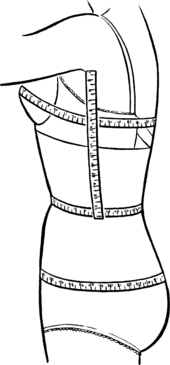Bust/waist/hip measurements

Bust/waist/hip measurements (informally called vital statistics) are a common method of specifying body proportions for the purpose of fitting clothes. They match the three inflection points of the female body shape. It is also often used in women's personal ads or Internet profiles to indicate their appearance. In human body measurement, the three sizes are the circumferences of the bust, waist and hips; usually rendered as three sizes: xx–yy–zz in inches, or centimeters. The three sizes are used mostly in fashion, and almost exclusively in reference to women,[1] who have a greater tendency to develop a waist that is narrowed in relation to the bust and hips.
Measurements and perception
Breast volume will have an effect on the perception of a woman's figure even when bust/waist/hip measurements are nominally the same. Brassiere band size is measured below the breasts, not at the bust. A woman with measurements of 37A–27–38 will have a different presentation than a woman with measurements of 35C–27–38. These women have ribcage circumferences differing by 2 inches, but when breast tissue is included the measurements are the same. The result is that the latter woman will appear "bustier" than the former due to the apparent difference in bust to hip ratios (narrower shoulders, more prominent breasts) even though they are both technically 38–27–38.
Height will also affect the presentation of the figure. A woman who is 36–24–36 at 5 ft 3 in (1.60 m) tall looks different from a woman who is 36–24–36 at 5 ft 8 in (1.73 m) tall. Since the latter woman's figure has greater distance between measuring points, she will likely appear thinner than her former counterpart, again, even though they share the same measurements.
The specific proportions of 36–24–36 inches (90-60-90 centimeters) have frequently been given as the "ideal", or "hourglass" proportions for women since at least the 1960s.[2][3][4]
See also
References
- ↑ Khamsi, Roxanne (2007-01-10). "The hourglass figure is truly timeless". NewScientist.com news service.
- ↑
- ↑
- ↑